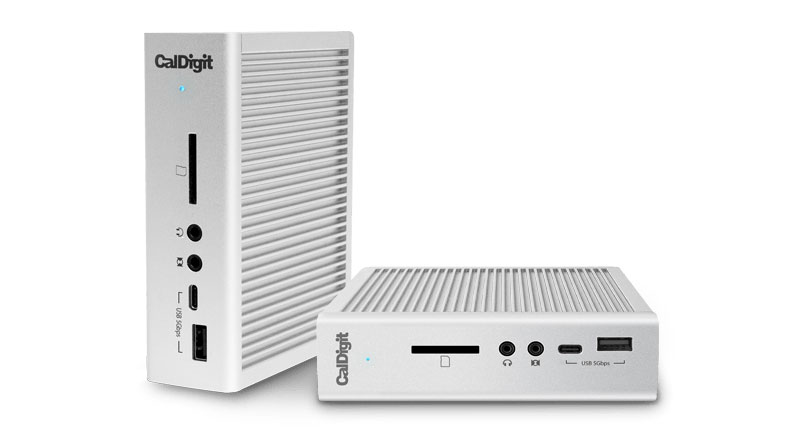Power Up with a Thunderbolt Dock That Can Handle All the Devices Your MacBook Pro Needs
Truth is, most Thunderbolt 3 docks on the market are seriously underpowered. There may be a valid reason for this on an engineering level, but I don’t think so. More likely it’s a case of unwise cost-cutting, plain and simple.
For many of us who use a later-model MacBook Pro, the laptop requires 60–85W for charging at maximum rate and efficiency. Connecting one or two Thunderbolt HDDs to an external dock typically requires about 15W of additional power per device. Add a few usual USB peripherals like a memory card reader and a photo scanner at 7.5W each, then an SSD high-speed drive for offloading original camera footage at 5W, and suddenly we are demanding 40-50W of additional power. Clearly, we need more than the 60W provided by most manufacturers’ docks; this meager amount can barely charge a 15-inch MacBook Pro operating alone and unencumbered.

Click to enlarge.
Unlike most Thunderbolt 3 docks, the CalDigit TS3 Plus provides ample 85W of power for properly charging a MacBook Pro or PC laptop. The TS3 provides seven (7) USB ports, the most of any dock available, including a high-speed USB 3.1 Gen 2 (10Gbps) port. Interestingly and most unusual, the TS3 can operate either horizontally or vertically, a significant advantage given the lack of desktop real estate that many of us must contend with.
CalDigit

In total, peripheral devices like hard drives, photo scanners, and card readers can draw plenty of power.
CalDigit
The CalDigit TS3 Plus Thunderbolt 3 dock is one of the few units on the market that supplies 85W of continuous power for charging a host laptop. In all, the dock can provide a generous 180W, more than enough to power a panoply of devices on all 15 buses and connectors simultaneously. This is a unique advantage of the CalDigit TS3 dock — it provides the power we need for a wide range of peripherals while providing full charging power in excess of the 60W typically provided by most dock manufacturers.

The TS3 Plus features an unusually high-capacity 180W power supply (b), more than enough to simultaneously power a range of devices on all 15 USB, Thunderbolt, and miscellaneous connections.
Barry Braverman
The CalDigit power supply (provided) is engineered and manufactured to support the TS3’s enhanced capabilities. The power supply is a dedicated high-capacity unit, not a cheap off-the-shelf adapter repurposed from other less demanding uses and devices.

Worried about connecting a notoriously power hungry SuperDrive? Don’t be. The CalDigit TS3 Plus provides plenty of power for that too.
Apple
The TS3’s 180W capacity means the two Thunderbolt 3 40Gbps connectors in the back of the unit may be used simultaneously (unlike some competing docks) to power a full complement of TB3 storage drives and accessories. The dock also features a USB 3.1 Gen 2 connector for connecting fast SSD storage at 10Gbps, a key advantage for offloading massive 4K camera files when Thunderbolt is not an option.

The TS3 Plus+ features a latest-generation UHS-II SD card reader useful for offloading 4K camera files from camcorders like the Panasonic EVA1. At 312MBps, the v4.0 card reader offers more than twice the transfer speed of UHS-I readers found on other Thunderbolt 3 docks. Looking ahead, shooters will see increased use of the SDXC UHS-II card in new 4K camcorders from Panasonic and others.
One of the nice features of the TS3 Plus is the built-in UHS-II SD card reader. Many of us are spending more and more time on sets and late at night in hotel rooms offloading data-heavy camera original footage from SDXC UHS-II memory cards. My Panasonic EVA1 is an impressive camcorder in almost every way, but offloading cards via the on-board USB interface can be slow and frustrating. The v4.0 SD card reader can significantly reduce offload times by 75% or more. This has to be a good thing, especially as future firmware updates will enable even higher-bit-rate recording and concomitantly heavier data loads.

The TS3 Plus is the first Thunderbolt 3 dock to offer a USB 3.1 Gen 2 port (10 Gbps) to take better advantage of high-speed SSD devices. Personally I look forward to the day when the chaos of USB is behind us, and Thunderbolt 3 rules the roost, moving data along quite merrily at 40Gbps.
The CalDigit TS3 sports the latest DisplayPort v1.2, supporting very-high-resolution monitors beyond 4K. Notably, there is no Apple Mini DisplayPort in the TS3. (Limited to 4K resolution, the Mini DisplayPort appears now to be fading from the scene.) The TS3 v1.2 DisplayPort also eliminates the $30 adapter/dongle typically required by Apple laptops in order to connect a professional display.
There are many convenient aspects to the CalDigit TS3 Plus+ dock. For example, the dock includes a S/PDIF optical digital audio connector and analog connectors for a microphone and headset, which will be especially useful for purveyors of podcasts.

One of the many useful features of the TS3 is built-in support for dual 4K monitors. Professional editors never had it this good – or as easy.
While the CalDigit TS3 is competent and versatile, there is one point worth mentioning when comparing the TS3 Plus to competing Thunderbolt 3 docks: There is no built-in support for certain legacy formats like FireWire.
You’ll need the $30 dongle for that.










